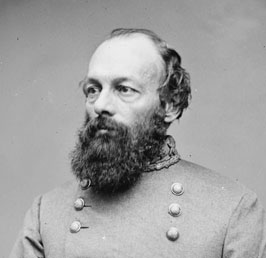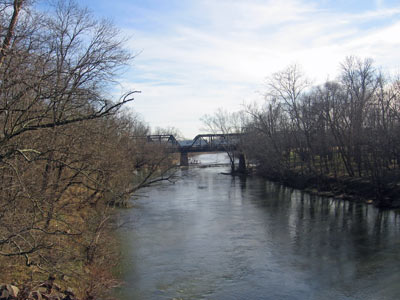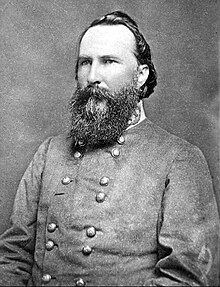 |
| Grant at Battle of Chattanooga (Thure de Thulstrop) |
HEADQUARTERS ARMY OF TENNESSEE, Missionary Ridge, November 24, 1863.
Lieutenant-General HARDEE:
GENERAL: The enemy is moving a large force up the river toward your right in the direction of the place where he is reported crossing the Tennessee. The general commanding has directed General Cleburne and his division to move to the right in that direction.
I am, general, very respectfully, your obedient servant,
GEORGE WM. BRENT,
Assistant Adjutant-General.
HEADQUARTERS DEPARTMENT OF THE CUMBERLAND, INSPECTOR GENERAL'S DEPARTMENT, Fort Wood, [November] 24, 1863-11 a.m.
Major-General THOMAS:
GENERAL: The enemy are moving by flank to our left on Missionary Ridge. [Signal from Colonel Barnett's battery, opposite side of river.]
G. M. L. JOHNSON,
Captain, and Acting Assistant Inspector-General.
LOOKOUT VALLEY, November 24, 1863-11 a.m.
Major-General REYNOLDS:
I am in condition to cross the creek, but as it will be attended with some considerable loss, I have deemed it advisable to await the arrival of Geary's command down its right bank before doing so. I think that he will be up as early as 12 o'clock.
JOSEPH HOOKER,
Major-General, Commanding.
LOOKOUT VALLEY, November 24, 1863-12.15 p.m.
Major-General REYNOLDS:
The valley is now clear. General Geary's division is on the crest of the slope of Lookout Mountain.
JOSEPH HOOKER,
Major-General, Commanding.
BALD MOUNTAIN SIGNAL STATION, November 24, 1863-12.20 p.m.
Major-General THOMAS:
General Howard's column has formed junction with Sherman.
C. A. DANA.
SIGNAL STATION OPPOSITE SIDE OF RIVER, November 24, [1863]-12.30 p.m.
General THOMAS:
Bridge completed.
DANA.
CAMERON HILL SIGNAL STATION, November 24, [1863.] [Received 12.30 p.m.]
Captain MERRILL:
Our forces have carried the works near white house, on Lookout.
HOWGATE.
FORT WOOD [FROM SIGNAL STATION OPPOSITE SIDE OF THE RIVER], November 24-1 p.m.
General THOMAS:
Woods is about to cross.
DANA.
HOOKER'S HEADQUARTERS, November 24, [1863]-1.25 p.m.
Major-General REYNOLDS:
In announcing the fact of our great success this morning I had no time to state its results. The conduct of all the troops has been brilliant, and the success has far exceeded my expectations. Our loss has not been severe, and of prisoners I should judge that we had not less than 2,000. The bulk of my infantry is now assembling on the east side of Lookout Mountain. Of course the routes do not admit of the passage of artillery.
HOOKER,
Major-General.
HDQRS. SECOND BRIG., FIRST DIV., FOURTH ARMY CORPS, White House, Lookout Mountain, Nov.24, [1863]-2 p.m.
Major-General REYNOLDS,
Chief of Staff:
I have established my headquarters in the white house, on Lookout Mountain. The enemy are massing rapidly on my right. Support me. Have taken two guns.
Respectfully,
W. C. WHITAKER,
Brigadier-General.
HDQRS. SECOND BRIG., FIRST DIV., 4TH ARMY CORPS, White House, on Lookout, November 24, [1863]-2 p.m.
Lieutenant-Colonel FULLERTON,
Chief of Staff:
I am in possession of the white house, on Lookout Mountain, and if I get ammunition I can hold it. The enemy are massing on my right.
Respectfully,
W. C. WHITAKER,
Brigadier-General.
HEADQUARTERS FOURTH ARMY CORPS, Chattanooga, Tennessee, November 24, 1863.
CAPTAIN: Can you let General Whitaker have ammunition? We have no ordnance officer, and General Granger is in the front.
Very respectfully,
J. S. FULLERTON,
Lieutenant-Colonel, and Assistant Adjutant-General.
HEADQUARTERS ARMY OF TENNESSEE, November 24, [1863]-2.30 p. m.
Major General C. L. STEVENSON,
Lookout Mountain:
GENERAL: The general commanding instructs me to say that you will withdraw your command from the mountain to this side of Chattanooga Creek, destroying the bridges behind. Fight the enemy as you retire. The thickness of the fog will enable you to retire, it is hoped, without much difficulty.
I am, general, very respectfully, yours,
GEORGE WM. BRENT,
Assistant Adjutant-General.
Major-General HOOKER:
General Thomas has just ordered the Moccasin Point battery to open on the Summertown road. Order sent by courier.
J. P. WILLARD,
Captain, and Aide-de-Camp.
HDQRS. SECOND DIVISION, TWELFTH ARMY CORPS,
Lookout Mountain, Tennessee, November 24, 1863-2.45 p.m.
Major General D. BUTTERFIELD,
Chief of Staff, Eleventh and Twelfth Army Corps:
GENERAL: We are pressed heavily, and need re-enforcements. We must have ammunition. I have sent for some, but it does not come. My rear should be well looked to.
Very respectfully, your obedient servant,
JNo W. GEARY,
Brigadier-General, Commanding.
SIGNAL STATION,
November 24, 1863.
General HOOKER:
Do you want any help?
J. M. PALMER,
Major-General.
NOVEMBER 24, [1863]
General PALMER:
Can hold the line I am now; can't advance. Some of my troops out of ammunition; can't replenish.
HOOKER,
Major-General.
HDQRS. SIGNAL CORPS, DEPT. OF THE CUMBERLAND, November 24, 1863.
Captain WILLARD,
Captain LEONARD:
Naylor's and Aleshire's batteries are firing at enemy in line of battle on our right, beyond rolling mills.
WOOD,
Lieutenant, and Signal Officer.
DEPARTMENT HEADQUARTERS, November 24, 1863-3.45 p.m.
General HOOKER:
Hold position until you can replenish ammunition. Brigade getting across Chattanooga Creek to support you.
By command of Major-General Thomas:
J. J. REYNOLDS,
Major-General.
HEADQUARTERS DEPARTMENT OF THE CUMBERLAND, Chattanooga, November 24, 1863.
Major-General HOOKER:
Your success is glorious. Resupply ammunition if possible. We are crossing a brigade to connect with you. Send prisoners to Kelley's Ferry to be guarded. Take accurate list.
J. J. REYNOLDS,
Major-General, Chief of Staff.
HEADQUARTERS ELEVENTH AND TWELFTH CORPS,
Lookout Mountain, Tennessee, November 24, 1863-4 p.m.
Brigadier-General GEARY,
Commanding Division:
After the fog lifts I except to descend into the valley, unless I receive orders to the contrary. The force I have there now should be able to hold it until that time. Our communications on the left with Chattanooga is established. In all probability the enemy will evacuate to-night. His line of retreat is seriously threatened by my troops.
Very respectfully,
JOSEPH HOOKER,
Major-General, Commanding.
LOOKOUT MOUNTAIN, November 24, 1863-4 p.m.
Major-General REYNOLDS:
It is so dark in Chattanooga Valley that it is impossible for me to see the position of the enemy or his numbers, and I deem it very imprudent to descend into it to-night. I hold the line from the white house to the point were the railroad passes beneath the mountain down the river on the Chattanooga side.
We have smart skirmishing along the line, particularly the upper part of it, but my troops are unflinching, and cannot be driven from their position, which they are strengthening every moment. The enemy continue to hold the top of Lookout Mountain, and I cannot prevent it until I can move around and take possession of the Summertown road, which, as I am informed, requires me to descend into the valley.
JOSEPH HOOKER,
Major-General, Commanding.
HEADQUARTERS ELEVENTH AND TWELFTH CORPS,
Lookout Mountain, Tennessee, November 24, 1863-4.50 p.m.
Brigadier-General GEARY,
Commanding Division: I congratulate you and your command on their glorious achievements of to-day. As the upper part of the line is most exposed, it has been stiffened with re-enforcements. As every inch of ground we have wrenched from the enemy to-day must be held until a renewal of the conflict, perhaps to-morrow, see that your troops get up their ammunition and strengthen their defenses.
Very respectfully,
JOSEPH HOOKER,
Major-General, Commanding.
LOOKOUT MOUNTAIN, November 24, 1863-5.15 p.m.
Major-General REYNOLDS:
General Carlin's brigade just reported to me. I have sent it to the right of my line, resting on the white house, as this was held by troops exhausted from the labors of to-day. At this point they will be in position to threaten the enemy's rear, if he does not retire before morning.
JOSEPH HOOKER,
Major-General, Commanding.
LOOKOUT MOUNTAIN, November 24, 1863-6.40 p.m.
Major-General REYNOLDS:
I am all right for to-night. In the morning I shall be short of batteries, though I hope to have the road and the bridges in condition to enable me to bring forward some of mine by the time I shall require them. The enemy had felled trees across the Chattanooga road over the mountain, and a slide in the road made it necessary to expend a good deal of labor upon it. From the dense fog to-day I have not been able to learn much of the topography of Chattanooga Valley in my front. For this reason I suggest that the operations of to-morrow be suspended until the fog lifts, if it should not require too much detention. I request that General Smith will forward me the map of which he spoke a day or two since.
JOSEPH HOOKER,
Major-General, Commanding.
HEADQUARTERS DEPARTMENT OF THE CUMBERLAND, Chattanooga, November 24, 1863-9.30 p.m.
Major-General HOOKER,
Lookout Valley:
The general commanding the department congratulates you most heartily upon your glorious success to-day, and desires that you convey his warmest thanks to the troops under your command for their valorous conduct. General Grant has just directed that General Sherman move along Missionary Ridge to-morrow with his force, while our force advances to the front, co-operating with Sherman and compelling the enemy to show whether he occupies his rifle-pits in our front. Be in readiness to advance as early as possible in the morning into Chattanooga Valley and seize and hold the Summertown road and co-operate with the Fourteenth Corps by supporting its right. Map sent by courier at 8 o'clock this evening.
J. J. REYNOLDS,
Major-General, Chief of Staff.
Official Records, Series I., Vol. 31, Part 2, Pages 108-112, 333-334, 678.
Hooker used three divisions (Geary's, Cruft's, and Osterhaus's) against Lookout Mountain. Grant did not authorize a full assault, agreeing only for Hooker to move forward if he met limited resistance. Hooker moved forward anyway, with Geary finding a defile between the mountain and river which was undefended. Greary swept along the base of Lookout Mountain and pushed the Confederaes under Walthall back to the Craven House. By 3PM thick fog enveloped the mountain. Sherman's three divisions crossed the river on the morning of the 24th and ended up misdeployed on a separate rise known as Billy Goat Hill. He took no further action. In the evening Bragg called a council of war and was persuaded to stick it out, while Grant adapted his plan and called for a double envelopment by Sherman and Hooker on the 25th.




















